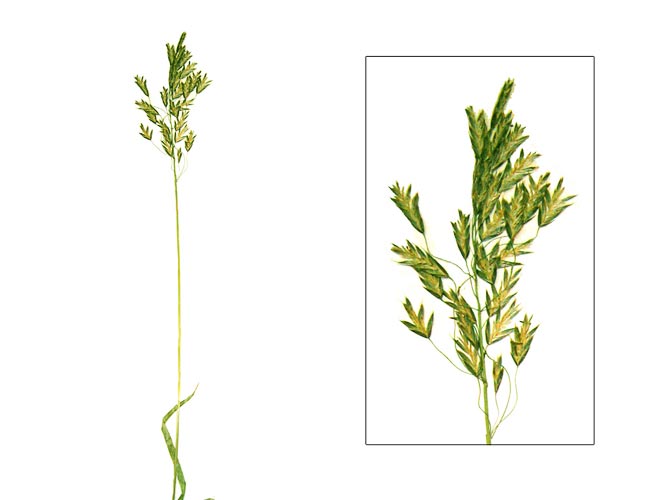Relatives
Bromopsis pumpelliana (Scribn.) Holub. - Pumpelly brome.
Taxonomic position.
Family Poaceae Barnhart., genus Bromopsis Fourr.Synonyms.
Bromus pumpellians Scribn., Bromus sibiricus Drob., Zerna occidentalis Nevski., Bromus uralensis Govor., Bromus inermis subsp. pumpellianus (Scribn.) Wagnon., Zerna pumpelliana (Scribn.) Holub., Bromopsis pumpelliana subsp. pumpelliana, Bromopsis sibirica (Drobov) Peshkova.Biology and morphology.
Perennial plant, robust, with long rhizomes. Root system is well-developed. Stems erect, up to 150 cm tall with pubescent nodes. Leaf blades up to 12 cm long, pubescent. Ligule very short (1 mm). Panicle-like inflorescence is oblong, sometimes compact, with compressed or diffuse branches, half-verticillate. Spikelets 1.2-1.4 cm long, with 3-12 flowers, sometimes lilac or red in color. Awn-pointed glumes are glabrous; lemmas are pubescent along ridges and have short awns. Seeds are 1.4-1.9 cm long, 2.0-2.2 cm wide, brown. Very polymorphic species with wide range of subspecies, forms and varieties. Blossoms in June; seeds ripen in August. Cross-pollinated by wind. Chromosome number: 2n = 28, 42, 56, 84.Distribution.
The Northern European section of Russia, Northern and Central Urals, Western Siberia from Northern Ural to Altay (though more rarely than Bromopsis inermis), all of Eastern Siberia, the Far East (especially the northern part). Well-known in North America.Ecology.
Mesophyte, adapted to temperate regions. Occurs in wet meadows, on slopes, along rivers on sands and stones, and among bushes up to the middle mountain zone (up to 2300 meters above sea level).Utilization and economic value.
Very valuable forage and pasture species for areas with severe winters. Resistant to drought, very cold-resistant and frost-resistant. Resistant to early fall and late spring frosts. Does well in all main soil types in forest and steppe zones, excluding acidic, salty and heavy soils. Does not tolerate shade. Tolerant to diseases. Can be used for hay, haylage. Good palatability. Improves soil structure and fertilization. Used for erosion control. Can also be used as a lawn grass. Species is cultivated in Siberia and in the European region of Russia.Literature cited:
Brezhnev D.D., Korovina O.N. 1980. Wild relatives of the cultivated plants of flora of the USSR. Leningrad: Kolos. 376 pp. (In Russian)Fedorov A.A., ed. 1974. Flora of the European part of the USSR. Leningrad: Nauka. V. 1. 404 pp. (In Russian)
Harkevich S.S., ed. 1982. Wild fodder grasses of Fast East. Moscow: Nauka. 240 pp. (In Russian)
Harkevich S.S., ed. 1985. Vasculare Plant of Soviet Far East. Saint Petersburg: Nauka. V. 1. 390 p. (In Russian)
Malyshev L.I., Peshkova G.A., eds. 1979. Flora of Central Siberia. Novosibirsk: Nauka. V. 1. 536 pp. (In Russian)
Malyshev L.I., Peshkova G.A., eds. 1990. Flora of Siberia. Novosibirsk: Nauka. V. 2. 361 pp. (In Russian)
Rodjevitz P.U., Schischkin V.K., eds. 1937. Flora of the USSR. Moscow-Leningrad: AN USSR. V. 2. 778 pp. (In Russian)
Tzvelev N.N. 1976. Poaceae USSR. Leningrad: Nauka. 788 pp. (In Russian)


